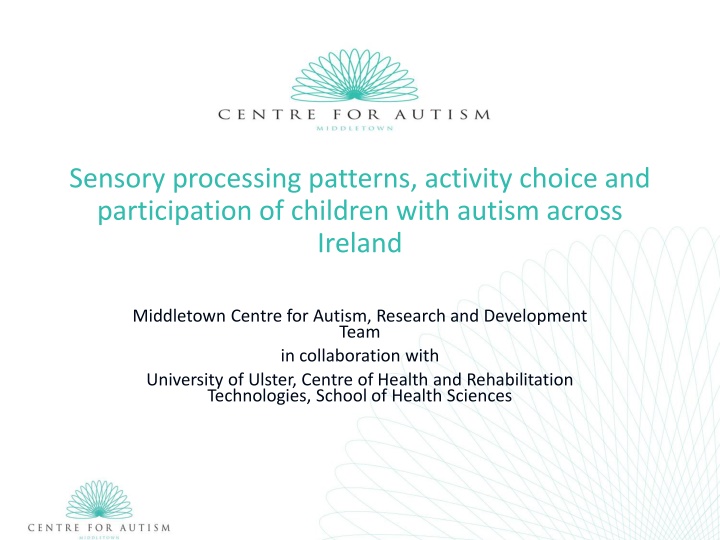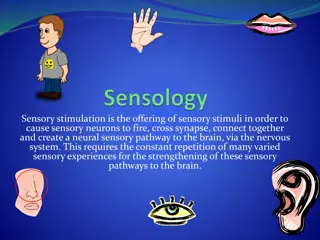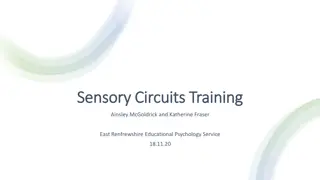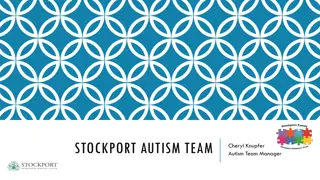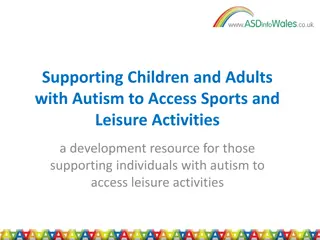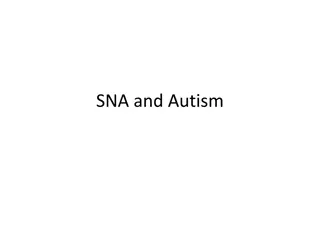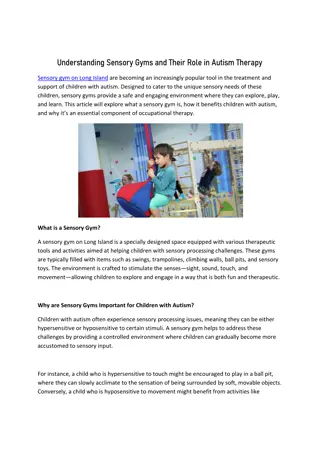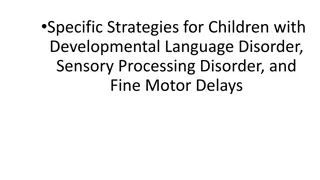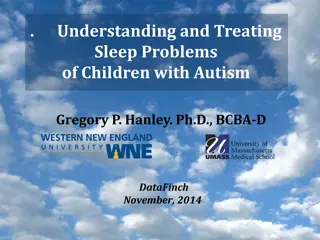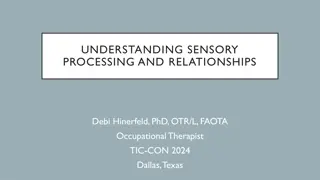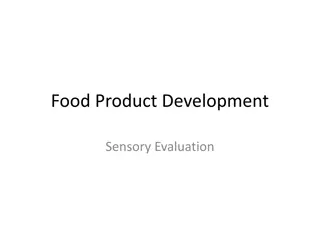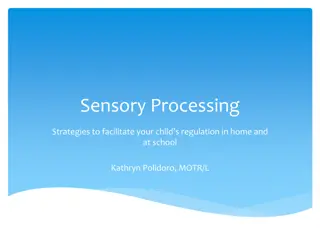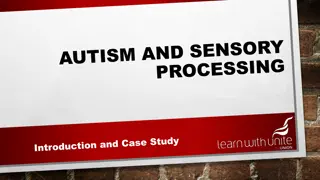Sensory Processing Patterns and Activity Choices of Children with Autism in Ireland
This study, conducted by the Middletown Centre for Autism Research and Development Team in collaboration with the University of Ulster, focuses on understanding the sensory processing patterns, activity choices, and participation of children with autism across Ireland. The research delves into the impact of these factors on the daily lives of children with autism, aiming to provide insights for better support and intervention strategies.
Download Presentation

Please find below an Image/Link to download the presentation.
The content on the website is provided AS IS for your information and personal use only. It may not be sold, licensed, or shared on other websites without obtaining consent from the author.If you encounter any issues during the download, it is possible that the publisher has removed the file from their server.
You are allowed to download the files provided on this website for personal or commercial use, subject to the condition that they are used lawfully. All files are the property of their respective owners.
The content on the website is provided AS IS for your information and personal use only. It may not be sold, licensed, or shared on other websites without obtaining consent from the author.
E N D
Presentation Transcript
Sensory processing patterns, activity choice and participation of children with autism across Ireland Middletown Centre for Autism, Research and Development Team in collaboration with University of Ulster, Centre of Health and Rehabilitation Technologies, School of Health Sciences
Introduction Participation in daily activities is fundamental to children s social, cognitive and physical development (Larson and Zemke, 2003; Law et al., 2004; Morgan and Long, 2012). For children with autism, participation in daily activities can be restricted by the core characteristics of the condition (Koenig and Rudney, 2010). Autism is estimated to effect between 1.13% and 2.64% of children globally (Baio, 2012; Kim et al., 2011). Previous research suggests that sensory preferences of children with autism are related to decreased participation in school, social, physical, leisure and family activities (Zingervich and LaVesser, 2009; Hochhauser and Engel, 2010; Bagby et al., 2012). No large scale research has investigated the impact of sensory preferences on activity choice and participation of children with autism in Ireland.
Objectives To determine the relationship between the sensory preferences of children with autism and the types of activity which they choose to participate in. To examine if the level of participation in these activities is affected by sensory preferences.
Methodology Ethical approval -University of Ulster Ethical Filter Committee. A convenience sample -(N= 161) parents of children with autism were recruited from across Ireland. Parents of children aged 4 11 years with a diagnosis of autism were included. Children with autism having other comorbid conditions such as visual, hearing or physical impairments or psychiatric conditions were excluded. Recruitment occurred in two stages: Stage 1: Invitation to attend Research Workshops 32 parents consented and completed both questionnaires. Stage 2: Emailed primary schools in Northern Ireland and Ireland 228 parents responded to take part, 182 met the inclusion criteria. 129 participants completed and returned both questionnaires and consent forms. Procedure Two Questionnaires & Consent Form. Sensory Profile (SP) (Dunn, 1999). Participation and Environment Measure Children and Youth (PEM-CY). The PEM-CY was developed by Wendy Coster, Mary Law and Gary Bedell. Permission to use the Measure was obtained through a license from McMaster University.
Outcome Measures Demographic on line questionnaire Created by researchers at Middletown Centre for Autism Questions on family characteristics Participation and Environment Measure Children and Youth (PEM-CY) A caregiver report - includes 25 items on participation in activities in the home , school and community. For each activity, the caregiver reports on the child s participation frequency; level of involvement; and desire for change in frequency and involvement in each activity. The Sensory Profile (SP) A caregiver questionnaire with 125 items which describe sensory responses to stimuli, including frequency of response to sensory stimuli using a 5 point Likert scale (never, seldom, occasionally, frequently and almost always).
Data Analysis Data analysed using SPSS software (Version 21). Descriptive statistics To determine the type and frequency of participation in each activity. To identify the sensory characteristics of the population. Multiple regression To examine the extent to which sensory preferences and family demographics were related to the PEM-CY categories.
Summary of Results Demographics N = 161 parents of children with autism (61 from Northern Ireland; 100 from Ireland). Majority mothers (74.5%) with a third level education or higher (68%). Most were boys with autism (63%) aged 8 9 years (27%). PEM-CY The majority of parents reported that their children: Participated most frequently in solitary activities - playing computer games (63%) watching T.V. (80%) (Table 1). Engaged less or never in social situations and unpredictable activities - taking part in clubs or teams in school (68%) and the community (75%). Displayed a high level of involvement in solitary activities - engaged on a daily bases (Table 2). Regularly engaged in activities - socialising at home (45%), performing personal care (71%), doing homework (62%), taking part in classroom activities (70%) and hanging out with peers in school (41%), however results suggest that the majority of children were only somewhat involved in these activities. Parents reported that they wanted their children: To play computer games (36%) and watch T.V (47%) less often. To be involved in a wider variety of activities. Sensory Profile The majority of children were identified as having a definitely different reaction to everyday sensory stimuli when compared to standardised scores of typically developing children defined by the SP (Dunn, 1999). Categories of Registration (70.8%), Seeking (67.1%), Sensitivity (77.6%), Avoiding (76.4%), Auditory (72%), Vestibular (70.8%), Touch 68.9%) and Multisensory (72%) (Table 3).
Summary of nResults Multiple Regression Analysis - To evaluate how well the SP scores in Registration, Seeking, Sensitivity, Avoiding, Auditory, Vestibular, Touch and Multisensory predicted the frequency and involvement of children with autism in a range of activities as set out in the PEM-CY. The significance level for all statistics was determined at the 0.05 level. Frequency of participation The model explained a small amount of variance in the frequency with which children with autism watched T.V (12.6%, p<.05), performed personal care (10.4%, p<.05), carried out homework (17.1%, p<.001) and took part in unstructured physical activities in the community (9.5%, p<.05). Intensity of involvement The model explained a small amount of variance in the level of involvement children with autism engaged in household chores (9.9%, p<.05), personal care tasks (17%, p<.001), homework (15.8%, p<.001), neighbourhood outings (10.5%, p<.05), hanging out with peers in the community (12.2%, p<.05) and staying overnight (10.1%, p<.05). Parent Activity The types of activities parents were involved in influenced the frequency the children with autism participated in school teams and clubs (13.7%, p<.05), attended community events (22.4%, p<.001), and performed household chores (17%, p<.05).
Limitations The homogeneity of the participants who volunteered for this study. It is likely a cross sectional study would elucidate different results. Some activities in the PEM-CY may not have been appropriate for the age group of children in this study (e.g. work and staying over with friends). Results are based on the perceptions of parents; social desirability and recall bias may have influenced results. These measurements could have been strengthened by direct observations or recruiting children to participate.
Implications for Practice In order to maximise the potential development of a child with autism, parents, professionals and care givers should consider: The child s sensory needs How their sensory preferences may be impacting on everyday life and engagement in everyday activities. SP and PEM-CY can be used to identify the sensory needs and activity choices of children with autism to: Direct appropriate interventions to facilitate improved activity engagement and performance.
Conclusion Results contribute to current knowledge by suggesting that: Sensory preferences influence the frequency and level of engagement children with autism participate in a range of activities in the home, school and community environment. Future research should focus on: Investigating the effects of sensory responses and participation in activities over time to further understand the developmental trajectory and effects of limited activity participation on the life course.
References American Psychiatric Association. (2013). Diagnostic and statistical manual of mental disorders (DSM-5). Arlington, VA: American Psychiatric Publishing Bagby, M. S., Dickie, V. A., & Baranek, G. T. (2012). How sensory experiences of children with and without autism affect family occupations. The American Journal of Occupational Therapy, 66(1), 78-86. Bedell, G., Coster, W., Law, M., Liljenquist, K., Kao, Y. C., Teplicky, R., ... & Khetani, M. A. (2013). Community participation, supports, and barriers of school- age children with and without disabilities. Archives of physical medicine and rehabilitation, 94(2), 315-323. Bundy, A. C., Shia, S., Qi, L., & Miller, L. J. (2007). How does sensory processing dysfunction affect play?. American Journal of Occupational Therapy, 61(2), 201. Cosbey, J., Johnston, S. S., Dunn, M. L., & Bauman, M. (2012). Playground behaviors of children with and without sensory processing disorders. OTJR: Occupation, Participation and Health, 32(2), 39-47. Coster WJ, Law MC, Bedell GM. (2010). Participation and environment measure for children and youth (PEM-CY). Boston (MA): Boston University. Dunn, W. (1999). The Sensory Profile: Examiners Manual. San Antonio, TX: The Psychological Corporation. Coster, W., Law, M., Bedell, G., Liljenquist, K., Kao, Y. C., Khetani, M., & Teplicky, R. (2013). School participation, supports and barriers of students with and without disabilities. Child: care, health and development, 39(4), 535-543. Engel-Yeger, B. (2008). Sensory processing patterns and daily activity preferences of Israeli children. Canadian Journal of Occupational Therapy, 75(4), 220- 229 Hochhauser, M., & Engel-Yeger, B. (2010). Sensory processing abilities and their relation to participation in leisure activities among children with high- functioning autism spectrum disorder (HFASD). Research in Autism Spectrum Disorders, 4(4), 746-754. Kim, Y. S., Leventhal, B.L., Koh, Y.J., et al. (2011). Prevalence of autism spectrum disorders in total population sample. American Journal of Psychiatry 168:904-912. Koenig, K. P., & Rudney, S. G. (2010). Performance challenges for children and adolescents with difficulty processing and integrating sensory information: A systematic review. The American Journal of Occupational Therapy, 64(3), 430-442. Larson, E. A., & Zemke, R. (2003). Shaping the Temporal Patterns of our Lives: The Social Coordination of. Journal of Occupational Science, 10(2), 80-89. Law, M., Finkelman, S., Hurley, P., Rosenbaum, P., King, S., King, G., & Hanna, S. (2004). Participation of children with physical disabilities: relationships with diagnosis, physical function, and demographic variables. Scandinavian Journal of Occupational Therapy, 11(4), 156-162. Law, M., Anaby, D., Teplicky, R., Khetani, M. A., Coster, W., & Bedell, G. (2013). Participation in the home environment among children and youth with and without disabilities. The British Journal of Occupational Therapy, 76(2), 58-66. Morgan, R., & Long, T. (2012). The effectiveness of occupational therapy for children with developmental coordination disorder: a review of the qualitative literature. The British Journal of Occupational Therapy, 75(1), 10-18. Reynolds, S., Bendixen, R. M., Lawrence, T., & Lane, S. J. (2011). A pilot study examining activity participation, sensory responsiveness, and competence in children with high functioning autism spectrum disorder. Journal of autism and developmental disorders, 41(11), 1496-1506. Tomchek, S. D., & Dunn, W. (2007). Sensory processing in children with and without autism: a comparative study using the short sensory profile. The American Journal of Occupational Therapy, 61(2), 190-200. Zingerevich, C., & LaVesser, P. (2009). The contribution of executive functions to participation in school activities of children with high functioning autism spectrum disorder. Research in Autism Spectrum Disorders, 3(2), 429-437.
